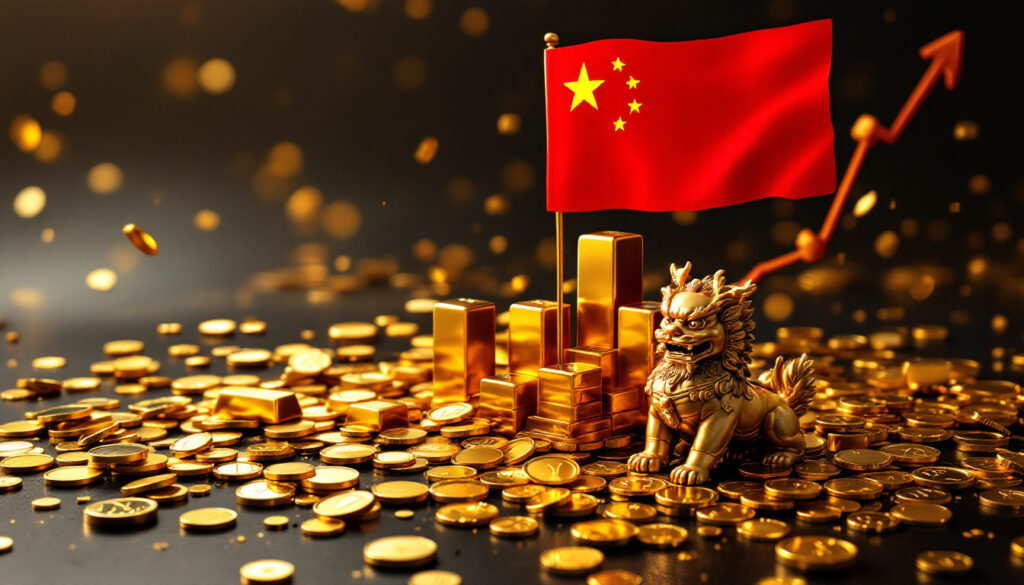Why is China Increasing its Gold Reserves?
The Six-Month Gold Acquisition Streak
China's central bank has been on a remarkable gold-buying spree, consistently expanding its precious metal holdings for six consecutive months. In April 2025 alone, the People's Bank of China (PBOC) added approximately 70,000 troy ounces to its reserves, continuing a methodical acquisition strategy that has brought nearly 1 million ounces (about 30 tons) into national holdings during this six-month period.
The steady pace of these purchases speaks volumes about China's deliberate approach to strengthening its gold position. Rather than making sporadic large acquisitions that might disrupt markets, the PBOC has maintained a measured tempo, demonstrating strategic patience even as all-time high gold prices have fluctuated throughout 2025.
Strategic Diversification Away from the US Dollar
At the heart of China's gold accumulation lies a clear strategic objective: reducing dependence on US dollar-denominated assets. This diversification strategy reflects growing concerns in Beijing about the vulnerability of US-based investments amid escalating trade tensions between the world's two largest economies.
"Likely we will see ongoing purchases by China's central bank as they scale back on US dollar denominated assets," notes Ross Norman, CEO at Metals Daily, highlighting the connection between gold acquisition and dollar diversification.
This move isn't happening in isolation. China's strategy represents part of a broader global trend among central banks seeking to rebalance their reserve portfolios. Following the 2022 freezing of Russian reserves during geopolitical conflicts, many nations have reassessed their financial sovereignty and the wisdom of concentrated holdings in any single currency.
Gold's traditional role as a store of value that exists outside the international banking system makes it particularly attractive as geopolitical uncertainties increase. Unlike currency reserves that can potentially be sanctioned or frozen, physical gold holdings provide a form of monetary insurance that remains under a nation's direct control.
Economic Challenges Driving Reserve Strategy
China's gold reserve expansion is unfolding against a backdrop of mounting economic pressures. The country faces a complex set of challenges including property market troubles, sluggish consumer spending, and manufacturing sector headwinds. These domestic economic concerns have prompted Beijing to implement a multi-faceted response.
Beyond gold acquisition, recent monetary policy measures include reducing policy rates and lowering reserve requirements for commercial lenders to stimulate economic growth. These monetary easing steps, coupled with the gold reserve expansion, demonstrate a comprehensive approach to economic stabilization.
The PBOC is balancing multiple objectives simultaneously: addressing immediate economic growth concerns through monetary stimulus while taking longer-term steps to strengthen financial sovereignty through gold accumulation. This dual approach reflects the nuanced economic management strategy Beijing is deploying amid both domestic pressures and international trade friction.
How Does China's Gold Strategy Compare Globally?
Current Position in Global Gold Reserve Rankings
China's central bank currently maintains approximately 8% of its total reserves in gold, according to Goldman Sachs analysis. This percentage stands significantly below the global average of 20% and substantially lower than many developed economies, where gold often represents 60% or more of total reserves.
This comparative underweight position in gold suggests considerable room for continued expansion of China's holdings if the country aims to align with international norms. The gap between China's current position and global benchmarks provides context for understanding the potential scale of future acquisitions if Beijing decides to pursue reserve composition parity with other major economies.
The relatively modest gold position also offers China substantial flexibility to increase holdings without dramatically altering its overall reserve strategy. Rather than representing a radical shift, the current acquisition program appears to be a gradual rebalancing toward greater diversification and financial sovereignty.
The Five-Fold Increase in Central Bank Gold Purchasing
China's gold strategy aligns with a remarkable global trend: central banks worldwide have dramatically increased their gold purchases approximately five-fold since 2022. This surge followed the freezing of Russian reserves during geopolitical conflicts, which served as a wake-up call for many nations regarding potential vulnerabilities in traditional reserve assets.
Goldman Sachs describes this development as a "structural shift in reserve-management behavior" rather than a temporary trend. The fundamental reconsideration of reserve composition represents a significant evolution in central banking philosophy globally – one that prioritizes asset security and sovereignty alongside traditional concerns like liquidity and yield.
Chinese officials have not publicly linked their gold acquisition strategy to these geopolitical concerns, but the timing and persistence of their purchases suggest awareness of the changing reserve management landscape. By participating in this global pivot toward gold, China positions itself within a broader movement while pursuing its specific strategic objectives.
Projected Timeline for Reserve Rebalancing
If China were targeting the global average allocation of 20% gold in its reserves while maintaining its current acquisition pace of approximately 40 tons monthly, Goldman Sachs estimates it would take roughly three years to reach this benchmark. This multi-year timeline underscores the long-term nature of China's strategy.
The measured approach allows China to build reserves without creating dramatic market dislocations through sudden large purchases. By maintaining a steady pace over years rather than months, the PBOC minimizes price impacts while steadily strengthening its position – a strategy that balances immediate market considerations with long-range objectives.
This potential three-year horizon also aligns with China's typical policy planning timeframes, suggesting a deliberate strategy rather than an opportunistic or reactive approach. The consistency of purchases despite price fluctuations further supports the view that this represents a structural shift in China's reserve management philosophy.
What Factors Are Driving Gold's Price Performance?
Record-Breaking Price Movements in 2025
Gold has achieved successive price records throughout 2025, with values increasing nearly 30% since January. This remarkable performance stands in stark contrast to the volatility experienced in many other asset classes, highlighting gold's enduring appeal during periods of economic uncertainty.
The precious metal's strong performance provides favorable conditions for China's reserve expansion strategy. While the PBOC maintains a price-sensitive approach to purchases, the overall upward trajectory in gold market performance validates the timing of China's multi-year acquisition program that began before the current price surge.
Market analysts note that gold's resilience amid fluctuating economic indicators demonstrates its unique position in the global financial ecosystem. Unlike bonds or equities that respond primarily to economic growth and interest rate expectations, gold often strengthens during periods of geopolitical tension and monetary uncertainty – precisely the conditions that have characterized much of 2025.
Investment Demand Amid Trade Tensions
The ongoing US-China trade conflict has unsettled financial markets globally, raising concerns about US asset stability and driving increased demand for safe-haven investments. Institutional investors have boosted gold allocations as portfolio insurance against geopolitical and economic disruptions.
This market uncertainty has contributed significantly to gold's price appreciation and validates China's strategic reserve diversification approach. As tensions escalate and retaliatory measures affect global trade, traditional financial assets become increasingly correlated, whereas gold maintains its historical role as a diversification tool during market stress.
Investor sentiment continues to favor precious metals as geopolitical tensions persist, with trading volumes and ETF flows reflecting sustained interest in gold exposure. This alignment between central bank purchasing (led by China) and private investor behavior creates robust support for breaking gold records in the current environment.
Domestic Chinese Investor Behavior
Within China itself, individual and institutional investors have demonstrated growing interest in gold, with trading volumes on the Shanghai Futures Exchange reaching historic highs in recent weeks. This domestic appetite reflects similar concerns about economic stability and inflation that are driving the central bank's acquisition strategy.
This local demand surge has prompted the PBOC to issue additional import quotas to commercial banks, allowing greater volumes of bullion to enter the country. These regulatory adjustments facilitate both central bank reserve building and meet private sector demand without creating artificial supply constraints.
The alignment between institutional and retail investor behavior indicates a broad-based shift toward precious metals within China's financial system. This grassroots support for gold ownership complements the central bank's strategic objectives, creating domestic market conditions that reinforce the PBOC's reserve diversification program.
How Does China Execute Its Gold Acquisition Strategy?
Price-Sensitive Purchasing Approach
China's central bank employs a disciplined, price-sensitive approach to gold acquisition that balances accumulation goals with cost management. According to Ross Norman, CEO at Metals Daily, "The modest volumes bought over the last few months suggest that while they are buyers, they will only do so if the price is attractive."
This strategic patience allows China to optimize its purchasing power while steadily building reserves. Rather than rushing acquisitions regardless of market conditions, the PBOC appears to modulate its buying tempo based on price movements – increasing volumes during dips and potentially scaling back during price surges.
Market observers note that this approach minimizes market impact while maintaining a consistent presence. By avoiding predictable purchasing patterns that might be exploited by traders, China maximizes its buying efficiency while steadily progressing toward its longer-term reserve objectives.
Import Quota Management System
The PBOC regulates gold flows into the country through a sophisticated quota system for commercial banks. These import allowances serve as the primary mechanism for controlling the domestic gold supply while meeting both institutional and investor demand.
Recent increases in these quotas signal the government's commitment to facilitating greater gold availability within China's financial system. By adjusting these regulatory parameters, authorities can ensure sufficient supply for both central bank acquisition and private market needs without creating distortions in domestic pricing relative to international markets.
This administrative approach to supply management represents an important aspect of China's gold strategy. The quota system provides authorities with precise control over inflows, allowing for responsive adjustment based on market conditions, domestic demand fluctuations, and the central bank's own acquisition timetable.
Coordination with Economic Policy Adjustments
China's gold reserve expansion occurs alongside broader economic policy measures, including interest rate adjustments and reserve requirement modifications for banks. This coordinated approach demonstrates how precious metal acquisition fits within China's comprehensive economic management strategy rather than functioning as an isolated initiative.
When viewed in this broader context, gold accumulation represents just one component of a multifaceted approach to economic stabilization and financial sovereignty. The PBOC's simultaneous implementation of monetary easing to stimulate growth alongside reserve diversification illustrates the complementary nature of these policy tools.
This integration of gold strategy with broader economic policy underscores the strategic importance Beijing places on reserve composition. Rather than treating gold as a peripheral concern, Chinese authorities appear to view it as an integral element of their financial architecture – one that warrants coordination with other critical economic levers.
What Are the Global Implications of China's Gold Strategy?
Impact on International Gold Markets
China's sustained gold purchasing program represents a significant source of demand in global precious metals markets. As one of the world's largest economies continues its acquisition strategy, market participants must factor this consistent buying pressure into gold price forecast and supply-demand analyses.
The predictable nature of China's purchases provides a stabilizing element for market fundamentals. Unlike speculative demand that can quickly reverse, central bank acquisitions typically represent long-term holdings that effectively remove supply from the market for extended periods.
Industry analysts note that China's measured approach minimizes market disruption while maintaining steady support for prices. This disciplined strategy benefits both China itself (by avoiding price spikes from its own buying) and the broader gold market (by providing consistent demand without creating unsustainable momentum).
Shifting Dynamics in Reserve Currency Status
China's move to reduce US dollar exposure through gold acquisition contributes to gradual changes in the international monetary system's structure. While not directly challenging the dollar's reserve currency status, these actions represent incremental steps toward a more diversified global reserve system.
The long-term implications could include reduced dollar dominance in international trade and finance. As multiple nations, led by major economies like China, diversify their reserves away from concentrated dollar positions, alternative mechanisms for international settlement and reserve management gain momentum.
This evolution will likely unfold gradually rather than through abrupt changes. The dollar's entrenched position in global finance, combined with the absence of ready alternatives at scale, suggests a transition measured in decades rather than years. Nevertheless, China's consistent gold acquisition represents one force among many pushing toward a more multipolar monetary system.
Influence on Other Central Banks' Strategies
China's gold acquisition program may influence other central banks' reserve management approaches, particularly among emerging market economies seeking greater financial sovereignty. The demonstration effect of a major economic power diversifying away from traditional reserve currencies could accelerate similar moves by other nations concerned about geopolitical risks to their financial assets.
This potential cascade effect represents one of the most significant long-term implications of China's strategy. If multiple central banks follow China's lead in reducing dollar exposure through gold acquisition, the cumulative impact could substantially alter global monetary dynamics and create sustained support for precious metals prices.
The psychological impact may prove as important as the direct market effects. China's actions signal that reserve diversification has entered the mainstream of central banking strategy rather than remaining a peripheral concern of smaller economies. This normalization of gold as a core reserve asset potentially marks a significant shift in global financial architecture.
FAQ: China's Gold Reserve Strategy
How much gold does China currently hold in its reserves?
While precise figures are subject to China's disclosure policies, analysis suggests the PBOC holds approximately 8% of its reserves in gold, significantly below the global average of 20%. The central bank has been consistently adding to these holdings, with approximately 30 tons acquired over the most recent six-month period.
This relatively modest position compared to international averages provides substantial room for continued expansion if China chooses to align more closely with global norms. At current acquisition rates, reaching the 20% benchmark would require a multi-year commitment to steady purchasing.
What is driving China's interest in expanding its gold reserves?
Multiple factors motivate China's gold acquisition strategy:
- Reducing dependence on US dollar-denominated assets
- Hedging against trade war risks and economic sanctions
- Diversifying reserve holdings for long-term financial stability
- Aligning with the global trend of increased central bank gold purchases
- Building monetary sovereignty independent of international banking systems
This multifaceted motivation suggests the strategy is likely to persist regardless of short-term price fluctuations or changes in other economic variables. The structural nature of these concerns points toward a sustained commitment to gold accumulation.
How does China's gold purchasing affect global gold prices?
China's consistent but measured approach to gold acquisition provides steady support for gold prices without causing dramatic market disruptions. The central bank's price-sensitive purchasing strategy allows it to accumulate reserves while minimizing market impact, though the cumulative effect of sustained buying contributes to overall positive price sentiment.
Market analysts observe that China appears to modulate its purchases based on prevailing prices, potentially increasing volumes during price dips and scaling back during rallies. This disciplined approach helps maintain market equilibrium while steadily building the nation's holdings.
The psychological impact of China's buying may exceed its direct market effect, as other investors view the central bank's consistent interest as validation of gold's long-term value proposition.
Is China selling US Treasury holdings to buy gold?
While China has reduced its US Treasury holdings in recent years, there isn't a direct one-to-one relationship between Treasury sales and gold purchases. The central bank manages its overall reserve portfolio through multiple transactions across various asset classes.
However, the strategic direction clearly indicates a preference for reducing dollar exposure while increasing precious metal holdings. This rebalancing represents a gradual shift in portfolio composition rather than an immediate or complete abandonment of dollar assets.
The PBOC maintains substantial US dollar positions while incrementally diversifying into alternative assets, including gold. This measured approach allows China to adjust its reserve composition without triggering market disruptions that might devalue its existing dollar holdings.
What percentage of global gold reserves does China control?
China ranks among the top global holders of gold reserves, though its percentage of total global official gold holdings remains relatively modest compared to nations like the United States, Germany, Italy, and France. China's current acquisition strategy suggests this percentage will increase in coming years if purchasing patterns continue.
The nation's relative position in global gold reserves underscores the potential scale of future acquisitions if China decides to substantially increase its gold allocation. Given the size of China's overall reserves, even a modest percentage increase in gold allocation would represent significant tonnage entering central bank holdings.
Market participants watching this trend should consider both China's current position and its trajectory, as the direction of its reserve strategy may ultimately prove more significant than its present holdings.
Strategic Patience in Building Gold Reserves
China's methodical approach to expanding its gold reserves demonstrates strategic patience and disciplined execution amid complex economic challenges. The six-month acquisition streak reflects a long-term vision for reserve diversification rather than short-term tactical moves. By maintaining a price-sensitive purchasing strategy while steadily accumulating gold, China balances immediate market impact considerations with long-range financial sovereignty goals.
As domestic economic pressures mount and international trade tensions persist, gold's role in China's reserve strategy takes on increased significance. The central bank's actions suggest continued commitment to building precious metal holdings while carefully managing the pace and timing of acquisitions. This balanced approach allows China to strengthen its financial position without disrupting markets or revealing its full strategic intentions.
The broader implications of China's gold strategy extend beyond its own borders, potentially influencing global reserve management practices and contributing to gradual shifts in the international monetary system. As this strategy unfolds over coming years, market participants and policy analysts will closely monitor both the pace of China's acquisitions and their impact on global gold markets and investment strategies for gold.
Further Exploration:
Readers interested in learning more about central bank gold reserves can also explore related educational content available on China's continuing gold acquisitions, which offers additional perspectives on global precious metals markets and central bank strategies.
Ready to Discover the Next Mining Breakthrough?
Don't miss the next market-moving mineral discovery on the ASX. Discovery Alert's proprietary Discovery IQ model delivers instant notifications when significant discoveries are announced, giving you an edge before the wider market responds. Explore our dedicated discoveries page to see how past discoveries have generated exceptional returns.




